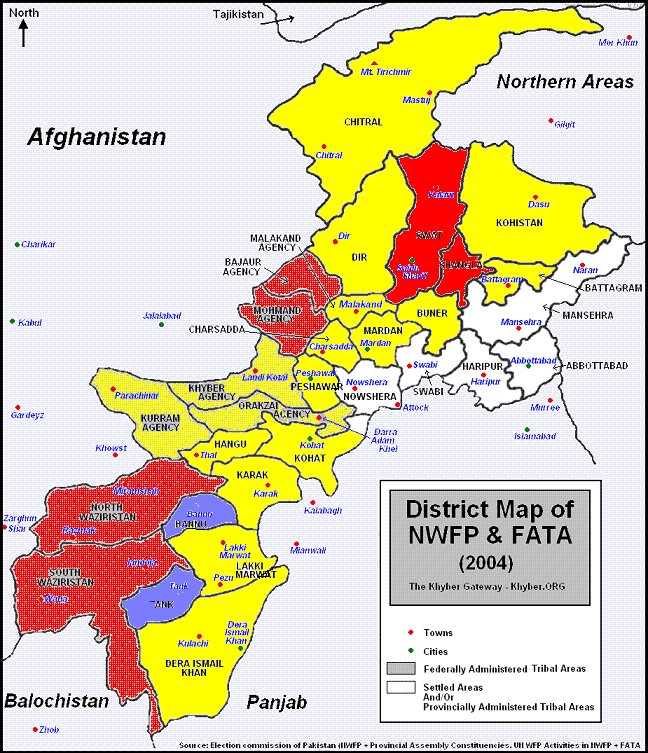It is a measure of the inter-connected character of our globalized world that the security of New York may be tied to events in distant, rugged and mysterious South Waziristan, Pakistan– a remote area even most Pakistanis know little about. And, US security may depend more on school-building and improving lives in South Waziristan than on unmanned drone attacks on militants.
The claim made by Hakimu’llah Mahsud, a leader of the Tehrik-i Taliban Pakistan (Taliban Movement of Pakistan), that his group was behind the failed attempt to set off an incendiary bomb in Time Square, is probably just grandstanding. The truck bomb discovered Saturday seems similar to the one used in the attack on Glasgow airport, which is to say that it mostly would have produced a burning SUV and was amateurish. The TTP is not an international organization and is a fringe rural group even among Pakistani Pashtuns, the ethnic group from which it springs. It does claim to have plotted an attack via expatriate followers in Barcelona, but that is probably grandstanding, as well. Still, there is no doubt that US and Pakistani actions in S. Waziristan do have security implications for both countries, and there is genuine reason to think that the approach in the last year to this issue in Washington and Islamabad has produced some undesirable side-effects and hurt civilian populations.
The Mahsud (Mehsud) tribe dwells predominantly in the Federally Administered Tribal Area of South Waziristan. These tribal areas in craggy territory are vaguely analogous to US Indian reservations, and they stretch along the border between Pakistan’s Kyber-Pukhtunkhwa (North-West Frontier) Province and Afghanistan. The Mahsud mounted a major rebellion against British India after the third Anglo-Afghan War in the late teens and early twenties of the twentieth-century and have long guarded their independence from centralizing governments and empires. (See my essay on Orientalist images of the Pashtuns in Tomdispatch.com last summer).
Some sections of the Mahsud tribe joined the militant Pakistani Taliban beginning a few years ago (unlike Afghan Taliban, who go back to the early 1990s, the Pakistani Taliban are a relatively recent development). TTP leader Baitu’llah Mahsud fought an insurgency against the Pakistani government and was blamed for the late 2007 assassination of former prime minister Benazir Bhutto.
The TTP leaders have been subjected to heavy US aerial bombardment via unmanned drones, and Baitu’llah Mahsud was killed by a missile strike on August 6, 2009. For an overview of this leader, see this Global Security site.
His successor, 28-year-old Hakimu’llah Mahsud, had been thought killed in a January, 2010, strike, but he survived and is now menacing US cities.
A big problem with the Obama administration’s approach to the Pakistani Taliban is that so far they have proffered only sticks and no carrots have been implemented. Last summer Washington prevailed on the Pakistani military to launch a campaign against the TTP in South Waziristan. It was carried out with much brutality and involved targeting members of the Mahsud tribe in general. South Waziristan is now under virtual military rule, many of its markets burned down, and its inhabitants subjected to constant checkpoint searches, as former ambassador Ayaz Wazir just described the situation. The displaced members of the Mahsud tribe are being threatened with death by the Taliban if they yield to Pakistani imploring to return to their homes, now under Islamabad’s military rule.
That is, in US military terms counter-insurgency would involve taking territory, clearing it of insurgents, holding it in the long term so as to reassure local populations they are safe, and then building an infrastructure of government services and a thriving economy. The Pakistani military has just taken and cleared. It isn’t providing enough security to allow the Mahsud to return to their homes. Although the US is dedicating monies for the “build” portion, it is not reaching South Waziristan at the moment, and take, clear– without the “hold” and “build” elements– is just brutal military occupation more likely to produce further insurgency than actual social peace.




 © 2024 All Rights Reserved
© 2024 All Rights Reserved